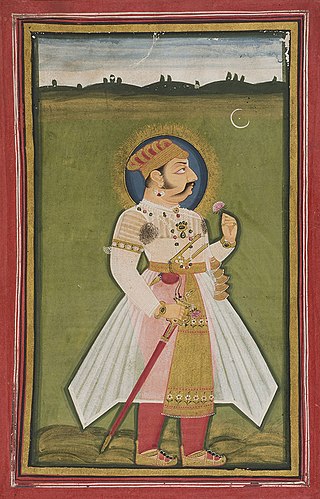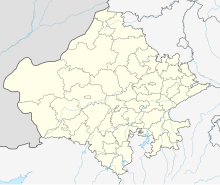
Sangram Singh I, commonly known as Rana Sanga, was the Rana of Mewar from 1508 to 1528 CE. A member of the Sisodia dynasty, he controlled parts of present-day Rajasthan, Gujarat and Madhya Pradesh with his capital at Chittor. His reign was admired by several of his contemporaries, including the first Mughal Emperor Babur, who described him as the "greatest Indian ruler" of that time. The Mughal historian Abd al-Qadir Badayuni called Sanga the bravest of all Rajputs along with Prithviraj Chauhan also known as Rai Pithaura.

The Battle of Khanwa was fought at Khanwa on 16 March 1527. It was fought between the invading Timurid forces of Babur and the Kingdom of Mewar led by Rana Sanga for supremacy of Northern India. The battle was a major event in Medieval Indian history although Timurids won at Panipat but at the time, the sultanate at Delhi was a spent force that was long crumbling. To the contrary, Kingdom of Mewar under the able rule of Rana Sanga and his predecessors, had turned into one of the strongest powers of northern India. The battle was among the most decisive battles in the Mughal conquest of northern India. It was among the earliest battles in Northern India where gunpowder was used to a great extent. The battle resulted in heavy casualties for both Timurids and Rajputs.

Rao Maldeo Rathore was a king of the Rathore dynasty, who ruled the kingdom of Marwar in present day state of Rajasthan. Maldeo ascended the throne in 1531 CE, inheriting a small ancestral principality of Rathore's but after a long period of military actions against his neighbours, Maldeo swept significant territories which included parts of present day Rajasthan, Haryana, Uttar Pradesh, Gujarat and Sindh. He refused to ally with either the Sur Empire or the Mughal Empire.

Kumbhkaran Singh (1417–1468), popularly known as Maharana Kumbha, was the ruler of the Kingdom of Mewar. He belonged to the Sisodia clan of Rajputs. It was during his reign that Mewar became one of the most powerful political powers in northern India. He is considered to be the most powerful ruler of his time in India.

The Kingdom of Amber, later the Kingdom of Jaipur or the Jaipur State, was located in the north-eastern historic Dhundhar region of Rajputana and was ruled by the Kachwaha Rajput clan. It was established by Dulha Rai, possibly the last ruler of the Kachchhapaghata dynasty of Gwalior who migrated to Dausa and started his kingdom there with the support of Chahamanas of Shakambhari with coalition of Gaur dynasty of sheopur in the 12th century. Mostly through 12th to 15th century, the kingdom faced stagnation, sources were scarce. Under its ruler, Raja Chandrasen of Amber became a Sisodia vassal and fought in the Battle of Khanwa under Raja Prithviraj Kachhwaha.

The history of human settlement in the western Indian state of Rajasthan dates back to about 100,000 years ago. Around 5000 to 2000 BCE many regions of Rajasthan belonged as the site of the Indus Valley Civilization. Kalibangan is the main Indus site of Rajasthan, here fire altars have been discovered, similar to those found at Lothal.

The Kingdom of Mewar was an independent Hindu kingdom that existed in the Rajputana region of the Indian subcontinent and later became a dominant state in medieval India. The kingdom was initially founded and ruled by the Guhila dynasty followed by the Sisodiya Dynasty. The kingdom came to be known as the Udaipur State after it became a princely state under British suzerainty in the nineteenth century.

Kingdom of Marwar, also known as Jodhpur State during the modern era, was a kingdom in the Marwar region from 1243 to 1818 and a princely state under British rule from 1818 to 1947. It was established in Pali by Rao Siha, possibly a migrant Gahadavala noble, in 1243. His successors continued to struggle against regional powers for domination and 9 out of 15 rulers till 1438 died in combat. In 1395, its capital was changed to Mandore by Rao Chunda of Mandore and to Jodhpur in 1459 by Rao Jodha.

The Mughal–Rajput wars were a series of battles between various Rajput Kingdoms and Dynasties with the Mughal Empire. The conflict originated with the invasion of India by Timurid King Babur, to which the most powerful Rajput state, Kingdom of Mewar under Rana Sanga, offered staunch resistance. The conflicts went on since 1526 for over 200 years. The conflict can broadly be divided into three phases: 1526 to 1556, which was indecisive; the second happened between 1556 to 1679, largely in Mughal favour; and third between 1679 to 1799, a period marked by Rajput dominance.
The Battle of Khatoli was fought in 1517 between the Lodi dynasty of the Delhi Sultanate under Ibrahim Lodi and the Kingdom of Mewar under Rana Sanga, during which Mewar emerged victorious.
The Battle of Dholpur in today's India occurred between the Kingdom of Mewar, led by Rana Sanga, and the Lodi dynasty of the Delhi Sultanate, commanded by Ibrahim Lodi, culminating in a victory for Mewar.

The Battle of Gagron was fought in 1519 between Mahmud Khalji II of Malwa and Kingdom of Mewar Rana Sanga. The conflict took place in Gagron and resulted in Sanga's victory, with him taking Mahmud captive and annexing significant territory.
In 1520 Rana Sanga, the Rana of Mewar, led Rajput armies of Kingdom of Mewar and its vassal states to invade the Gujarat Sultanate. He reinstated Raimal Rathore as the Rao of Idar and defeated the Gujarat forces under the command of Nizam Khan. Rana Sanga drove the army of Muzaffar II deep into Gujarat and chased them up to Ahmedabad. The Sultan of Gujarat was forced to flee to Muhammadabad. After a series of successful military campaigns Sanga successfully captured Northern Gujarat.

The siege of Mandsaur was a siege laid by Kingdom of Mewar forces under Rana Sanga against Gujarat Sultanate and Malwa Sultanate. The Sultan of Gujarat left Muhammadabad and returned to his capital after Rana Sanga had returned to Mewar after his campaign in Gujarat. He was grieved to see his treasuries looted and his palace destroyed and began to think of avenging his defeat. He set about preparing a large army, doubled the pay of the soldiers, and gave them a year's salary in advance.
Banvir, also known as Banbeer was the ruler of Mewar Kingdom between 1536 and 1540. He was nephew of Rana Sanga, born to his brother Prithviraj and his cocunbine.
The Battle of Singoli (1336) was fought between the forces of Mewar, led by Hammir Singh, and the Delhi forces, led by a commander of Muhammad Bin Tughlaq, at Singoli, in present-day Madhya Pradesh, India.
The Battle of Bayana or the Siege of Bayana was a military conflict between the Kingdom of Mewar under Rana Sanga on one side and Afghan of Bayana under Nizam Khan and Mughal advance guard, led by Abdul Aziz on other side.

The Mewar–Malwa conflicts were a series of wars between the Kingdom of Mewar and the Sultanate of Malwa. The conflict erupted due to mutual territorial expansion triggered by both sides on each other. The war was fought in the modern-day regions of Rajasthan and Madhya Pradesh. The Rana branch of the Guhilas, following their successful recovery of the Rajput stronghold of Chittorgarh and the entire region of Mewar alongside Rajputana after the Battle of Singoli, embarked on an ambitious expansion at the cost of their neighbouring kingdoms. On the other side, with the invasion of Timur, the Delhi Sultanate grew weak and many of its provinces gained independence which included Malwa, adjacent to Mewar.
The Kingdom of Mewar - Delhi Sultanate Conflict was a series of military engagements between the Kingdom of Mewar under the Sisodiya dynasty and the Delhi Sultanate from the regime of Tuqhlaq Dynasty to the succeeding ones. The conflict erupted when the Sisodiya dynasty took the reigon of Mewar from Delhi Sultanate's rule. The conflict was fought in what is today the Indian states of Rajasthan, Madhya Pradesh and Uttar Pradesh.











